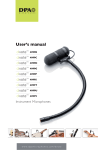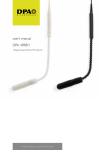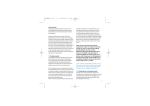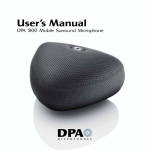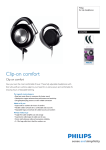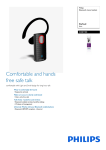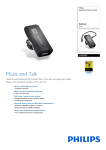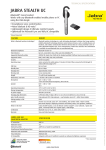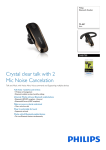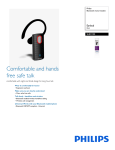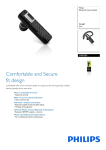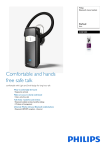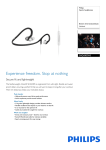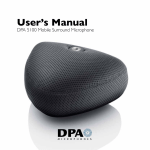Download user's manual - Event Projection
Transcript
user’s manual headset microphone Dual-ear Single-ear Short boom w w w. d p a m i c r o p h o n e s . c o m Omnidirectional characteristics •The microphone is sensitive to sound from all directions. •The sound remains more or less the same regardless of the distance between the sound source and the microphone. •The positioning of microphones with omnidirectional characteristics is less critical than with directional. •An omnidirectional microphone is generally not very sensitive to wind, breathing and handling noises. Directional characteristics •Rejects background noise and creates higher separation. •The microphone is most sensitive to sound on the side of the chevron. •The positioning of mics with directional characteristics is essential, as the low frequency level will change according to the distance to the mouth. Choose a distance which yields the desired amount of bass. •Care should be taken to protect against wind and pop noise. The directional characteristics of the microphone is indicated on the microphone head with for omnidirectional and for directional. This marking should always point towards the mouth. How to mount the DPA d:fine™ headset microphone For the single-ear, just open the spring hook lightly, first place the slide behind your earlobe and let go of the spring over you ear. How to adjust microphone boom & cable Position the microphone properly by pulling or pushing the boom along the slide. Switch between left and right ear wearing style simply by rotating the microphone boom. Hold on to the earhook while gently turning the boom. For the dual-ear versions, also rotate the two earhooks. The DPA d:fine headset microphone offers exchange of cables or microphone booms. Simply locate the service access point, pull back the small protection cap and gently pull the boom away from the cable hanger. Windscreens The enclosed windscreens offer additional protection against wind and pop noise. Gently draw the windscreen over the microphone head. For even better protection, bigger windscreens are available. Adjust the microphone boom to follow the shape of your face by gently bending the soft steel on the cable hanger. Adjust the angle of the cable run, also by gently bending the soft steel (see arrows). Position the cable as shown on the picture for securing the position of the microphone. The cable relief on the dual-ear version should be fixed in the clip that also holds the two wires on the mount. For the dual-ear, place the headset behind your ears and place the springs like for the single-ear. Adjust the headset mic by pulling or pushing the wires until it fits tight. Service point for exchange of cables or booms Accessories (see more at www.dpamicrophones.com) Grids and windscreens, cables and adapters, booms and earhooks Sweat stop & protection grid The microphone is equipped with a transparent sweat stop around the microphone boom to prevent sweat running along the microphone boom to the microphone head. A protection grid is mounted over the microphone head. If clogged with dirt or make-up, gently remove it and clean it with distilled water. Always leave the protection grid on the microphone, as it protects the inner grid and offers protection against wind and breathing noise. The protection grid is replaceable. Protection cap Maintenance DPA d:fine headset microphone is resistant to high levels of humidity. However, care must be taken to keep the headset microphone away from exposure to water and cleaning fluids, and to keep the microphone head dry at all times. Do not use spray or fluid containing chemicals that could remove static electricity on or close to the microphone. This could cause permanent damage. DPA d:fineTM headset microphone comes with a red plastic cap which serves to protect the microphone head when putting on make-up, hairspray and more. Remove the cap before use. Color codes & cable steer Cable maintenance Use organic oil (e.g. olive oil) or lukewarm distilled water to remove residue from tape, glue, or make-up on the cable. Do not bend the cable or rub it harshly, it may stress the inner cores of the cable and cause them to break over time. Frequency response d:fineTM omni headset microphone 10 0 dB -10 -20 -30 20 Hz 50 100 200 500 1 kHz 2 5 10 20 40 2 5 10 20 40 Frequency response d:fineTM directional headset microphone 10 0 dB -10 DPA d:fine headset microphone comes with a number of cable steer clips in different colours. Mounted on the cable relief, this clip allows for quick recognition of a specific headset microphone. -20 -30 20 Hz Service & repair If you are not satisfied with the characteristics exhibited by this product, please go to www.dpamicrophones.com/service for instructions. 50 100 200 500 1 kHz Black line is near field (2 – 3 cm/0.8 – 1.2 in). Green line is far field (more than 30 cm/12 in). Clothing clip The supplied clothing clip allows you to attach the cable to your clothes, thus relieving the cable draw to the headset mic. This is essential on the single-ear headset mic. © Copyright 2012 Warranty The d:finetm headset microphone is covered by a two-year limited warranty. CE marking This product conforms with all relevant directives approved by the European Commission. Product features and specifications are subject to change without notice. Directional characteristics Omnidirectional Principle of operation Pressure Frequency range 20 Hz - 20 kHz Frequency range, ± 2 dB 20 Hz - 20 kHz with 3 dB soft boost at 8 - 15 kHz Sensitivity, nominal, ± 3 dB at 1 kHz 6 mV/Pa; -44 dB re. 1 V/Pa Equivalent noise level, A-weighted Typ. 26 dB(A) re. 20 µPa (max. 28 dB(A)) S/N ratio (A-weighted), re. 1 kHz at 1 Pa (94 dB SPL) Typ. 68 dB(A) Total Harmonic Distortion (THD) <1 % up to 123 dB SPL peak <1 % up to 120 dB SPL RMS sine Dynamic range Typ. 97 dB Max. SPL, peak before clipping 144 dB Power supply (for full performance) Min. 5 V - max. 50 V through DPA adapter for wireless systems. 48 V phantom power ± 4 V with DAD6001-BC XLR adapter dpi-dfine-m Specifications d:fineTM omni headset microphone Specifications d:fineTM directional headset microphone Current consumption Typ. 1.5 mA (microphone) 3.5 mA with DAD6001-BC XLR adapter Connector MicroDot Color (microphone, cable and earhook) Black, beige, brown or lime (no lime cable available) Weight Microphone boom: 0.8 g (0.03 oz) Single-ear hook: 1.1 g (0.04 oz) Dual-ear hook: 3 g (0.1 oz) Cable: 6.6 g (0.23 oz) Total: 8.5 g (0.30 oz) Microphone head size (h x w x d) 9.5 x 5.3 x 2.9 mm (0.37 x 0.21 x 0.11 in) Capsule diameter 5.4 mm (0.2 in) Cable length 1.3 m (4.3 ft) Cable diameter 1.6 mm (0.06 in) Temperature range -40 °C to 45 °C (-40 °F to 113 °F) Relative Humidity (RH) Up to 90% Directional characteristics Cardioid Principle of operation Pressure gradient Frequency range 20 Hz - 20 kHz Frequency range, ± 2 dB, Near field 2-3 cm (0.8-1.2 in) 100 Hz - 20 kHz with 3 dB soft boost at 8 - 20 kHz Sensitivity, nominal, ± 3 dB at 1 kHz 6 mV/Pa; -44 dB re. 1 V/Pa Equivalent noise level, A-weighted Typ. 28 dB(A) re. 20 µPa (max. 30 dB(A)) S/N ratio (A-weighted), re. 1 kHz at 1 Pa (94 dB SPL) Typ. 66 dB(A) Total Harmonic Distortion (THD) <1 % up to 123 dB SPL peak <1 % up to 120 dB SPL RMS sine Dynamic range Typ. 95 dB Max. SPL, peak before clipping 144 dB Power supply (for full performance) Min. 5 V - max. 50 V through DPA adapter for wireless systems. 48 V phantom power ± 4 V with DAD6001-BC XLR adapter Current consumption Typ. 1.5 mA (microphone) 3.5 mA with DAD6001-BC XLR adapter Connector MicroDot Color (microphone, cable and earhook) Black, beige, brown or lime (no lime cable available) Weight Microphone boom: 0.8 g (0.03 oz) Single-ear hook: 1.1 g (0.04 oz) Dual-ear hook: 3 g (0.1 oz) Cable: 6.6 g (0.23 oz) Total: 8.5 g (0.30 oz) Microphone head size (h x w x d) 9.5 x 5.3 x 2.9 mm (0.37 x 0.21 x 0.11 in) Capsule diameter 5.4 mm (0.2 in) Cable length 1.3 m (4.3 ft) Cable diameter 1.6 mm (0.06 in) Temperature range -40 °C to 45 °C (-40 °F to 113 °F) Relative Humidity (RH) Up to 90%






